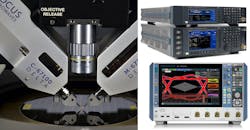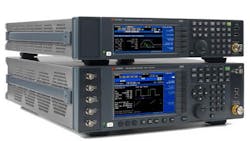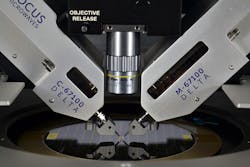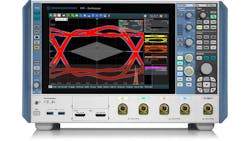Testing Interest in 5G at 2019 IMS Exhibition
Exhibition floors are usually a good place to demo some of the latest test gear and no floor of that ilk is better than the 2019 IEEE International Microwave Symposium (IMS) scheduled for June 2-7, 2019 at the Boston Convention and Exhibition Center. From casual experimenters to serious specifiers, test-equipment manufacturers are usually thrilled to show off their instruments and software, especially with the onrush of new applications in the microwave industry—particularly 5G wireless cellular networks and automotive radar systems for self-driving autonomous vehicles. Test equipment is important for every step in the design and development of a new device, component, or system, from prototyping to production, and the 2019 IMS exhibition will have a fair share of instruments worth investigating.
Generating signals is a starting point for many test setups, and Keysight Technologies (Booth 606) is showing its model M8195A arbitrary waveform generator (AWG). The AWG is designed in the AXIe module format for flexibility and ease of upgrading performance when needed. The signal source supplies 1, 2, or 4 differential channels in each one-slot-high AXIe module, with as much as 16 Gsamples of waveform memory per module. Multiple modules can be synchronized as might be needed for multiple-input, multiple-output (MIMO) antenna array testing.
The AWG operates at sample rates to 65 Gsamples/s with 8-b resolution, allowing it to generate signals with instantaneous bandwidths from dc to 25 GHz. The advanced architecture includes digital predistortion as part of its built-in frequency and phase-response calibrations, which make it possible to extract the effects of loss and phase delays in cables and connectors.
For electronic-warfare (EW) threat simulation and analysis, the N5193A agile signal generator from Keysight should have its share of visitors for demonstrations. While switching speed is a complex concept when including bus and cable delays, this test signal source typically provides CW frequency switching of 95 µs or faster.
The N5193A comes with many options, including frequency ranges of 10 MHz to 20 GHz or 10 MHz to 40 GHz, with 10-kHz standard CW frequency resolution and 0.001-Hz frequency resolution as a further option (Fig. 1). Frequency-switching modes can be selected with phase-continuous and phase-coherent modes, and power levels as high as +10 dBm to 20 GHz and +7 dBm to 40 GHz can be adjusted with mechanical and agile electronic attenuators.
1. The N5193A agile signal generator is well-suited for EW signal generation and simulation at frequencies to 40 GHz. (Courtesy of Keysight Technologies)
Of course, generating signals is only part of any test bench—a good analyzer is also needed. To meet the needs of ever-increasing signals in the microwave industry, Keysight will show its two- and four-port PNA-X network analyzers: model N5244B for 900 Hz to 43.5 GHz and model N5245B for 900 Hz to 50.0 GHz. These are powerful analyzers with typical system dynamic ranges of 122 dB or better to 40 GHz and 112 dB or better to 50 GHz.
National Instruments (Booth 930) will exhibit solutions for generating and analyzing signals at millimeter-wave (mmWave) frequencies, such as its mmWave Vector Signal Transceiver (VST). The modular PXI-based test system teams different PXI signal generator and analyzer modules in a PXI chassis, with a choice of different frequency ranges to meet the needs of different applications.
Signal generators can be selected by frequency range and instantaneous bandwidth, with available frequency ranges of dc to 500 MHz, 65 MHz to 6 GHz, and 5 to 44 GHz, and instantaneous bandwidths as wide as 1 GHz. Signal analyzers are available with frequency ranges of dc to 500 MHz, 65 MHz to 6 GHz, and 5 to 45 GHz, with instantaneous bandwidths as wide as 1 GHz. The firm will also demonstrate its popular LabVIEW software for automating and speeding electronic testing and its software-defined-radio (SDR) technology for developing wireless applications.
Pulling a Load
Focus Microwaves (Booth 1030) will provide demonstrations of its patent-pending DELTA series electromechanical load-pull tuners for on-wafer measurements. The low profile of the tuners makes it possible to place a probe tip within the perimeter of a semiconductor wafer to be tested while making a lossless direct connection between the probe tip and the tuner.
As an example, the model C-67100 DELTA load-pull tuner weighs just 2 lbs and is 6.7 in. long (Fig. 2). It’s designed to handle as much as 14 W CW power at fundamental frequencies from 10 to 67 GHz, with connections to other test gear by way of 1.85-mm coaxial connector. The typical repeatability is −50 dB. The firm also offers the model M-67100 DELTA load-pull tuner for (second and third) harmonic on-wafer load-pull testing from 10 to 67 GHz.
2. The C-67100 DELTA load-pull tuner is only 6.7 in. long, but it’s a key part of load-pull measurements at fundamental frequencies from 10 to 67 GHz. (Courtesy of Focus Microwaves)
Maury Microwave Corp. (Booth 618) will present some of its handy measurement accessories, including test fixtures, amplifiers, and its latest active load-pull tuners, such as the MT1000 and MT2000 mixed-signal multiple-harmonic active load-pull tuners. The tuners allow measurements on components and devices under real-world load conditions, like the impedance load imposed by connection to an antenna. The high-speed load-pull systems offer measurement bandwidths as wide as 1000 MHz. They are single-system solutions for load-pull testing at frequencies from 1 MHz to 40 GHz, using CW and pulsed test signals, without need to add signal generators and analyzers.
Based on its presence at the recent Automotive Testing Expo Europe 2019, Rohde & Schwarz (Booth 642) will offer practical measurement solutions for testing automotive radar systems at 77 to 81 GHz. The test systems employ downconverting frequency mixers, low-noise signal generators for local oscillators (LOs), and high-speed oscilloscopes for analysis (Fig. 3).
3. The R&S RTP Series of high-speed oscilloscopes offer 4- and 8-GHz bandwidths with high resolution. (Courtesy of Rohde & Schwarz)
For example, the R&S RTO2064 oscilloscope features a 6-GHz bandwidth with four measurement channels, 20-Gsample/s sampling rate, and 2-Gsample waveform memory. For automotive MIMO signal testing, the R&S RTP084 oscilloscope provides four phase-coherent channels and an 8-GHz bandwidth. Automotive radar sensor testing can be simplified with the help of the R&S AREG100A automotive radar echo generator, which can simulate as many as four static objects as radar targets.
Engineers working on oscillators and other signal sources will find the time well spent at Holzworth Instrumentation (Booth 679), where they can see the HA7062D Real Time Phase Noise Analyzer, introduced at last year’s IMS exhibition in Philadelphia. The compact analyzer measures the phase noise of oscillators and other sources from 10 MHz to 28 GHz, and optionally to 40 GHz, at offset frequencies of 0.1 Hz to 100 MHz from the carrier. The analyzer, which can also measure jitter, has a measurement noise floor of −190 dBc/Hz offset 10 kHz from the carrier.
These are just some examples of the many high-frequency test instruments on display at the 2019 IEEE IMS exhibition. Visitors have a chance to sort through the latest developments in measurement solutions and be part of demonstrations in many exhibition booths. It’s a learning experience that can also be quite entertaining.
About the Author
Jack Browne
Technical Contributor
Jack Browne, Technical Contributor, has worked in technical publishing for over 30 years. He managed the content and production of three technical journals while at the American Institute of Physics, including Medical Physics and the Journal of Vacuum Science & Technology. He has been a Publisher and Editor for Penton Media, started the firm’s Wireless Symposium & Exhibition trade show in 1993, and currently serves as Technical Contributor for that company's Microwaves & RF magazine. Browne, who holds a BS in Mathematics from City College of New York and BA degrees in English and Philosophy from Fordham University, is a member of the IEEE.




